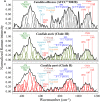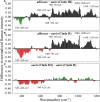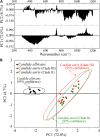Raman Imaging of Pathogenic Candida auris: Visualization of Structural Characteristics and Machine-Learning Identification
- PMID: 34867902
- PMCID: PMC8633489
- DOI: 10.3389/fmicb.2021.769597
Raman Imaging of Pathogenic Candida auris: Visualization of Structural Characteristics and Machine-Learning Identification
Abstract
Invasive fungal infections caused by yeasts of the genus Candida carry high morbidity and cause systemic infections with high mortality rate in both immunocompetent and immunosuppressed patients. Resistance rates against antifungal drugs vary among Candida species, the most concerning specie being Candida auris, which exhibits resistance to all major classes of available antifungal drugs. The presently available identification methods for Candida species face a severe trade-off between testing speed and accuracy. Here, we propose and validate a machine-learning approach adapted to Raman spectroscopy as a rapid, precise, and labor-efficient method of clinical microbiology for C. auris identification and drug efficacy assessments. This paper demonstrates that the combination of Raman spectroscopy and machine learning analyses can provide an insightful and flexible mycology diagnostic tool, easily applicable on-site in the clinical environment.
Keywords: Candida auris; Raman imaging; Raman spectroscopy; ergosterol; glucans; machine-learning.
Copyright © 2021 Pezzotti, Kobara, Asai, Nakaya, Miyamoto, Adachi, Yamamoto, Kanamura, Ohgitani, Marin, Zhu, Nishimura, Mazda, Nakata and Makimura.
Conflict of interest statement
The authors declare that the research was conducted in the absence of any commercial or financial relationships that could be construed as a potential conflict of interest.
Figures








Similar articles
-
Raman Study of Pathogenic Candida auris: Imaging Metabolic Machineries in Reaction to Antifungal Drugs.Front Microbiol. 2022 May 25;13:896359. doi: 10.3389/fmicb.2022.896359. eCollection 2022. Front Microbiol. 2022. PMID: 35694304 Free PMC article.
-
Raman Metabolomics of Candida auris Clades: Profiling and Barcode Identification.Int J Mol Sci. 2022 Oct 3;23(19):11736. doi: 10.3390/ijms231911736. Int J Mol Sci. 2022. PMID: 36233043 Free PMC article.
-
Application of Machine Learning Classifier to Candida auris Drug Resistance Analysis.Front Cell Infect Microbiol. 2021 Oct 15;11:742062. doi: 10.3389/fcimb.2021.742062. eCollection 2021. Front Cell Infect Microbiol. 2021. PMID: 34722336 Free PMC article.
-
[Candida auris: The Recent Emergence of a Multiresistant Pathogenic Fungi].Acta Med Port. 2020 Oct 1;33(10):680-684. doi: 10.20344/amp.12419. Epub 2020 Oct 1. Acta Med Port. 2020. PMID: 33135623 Review. Portuguese.
-
Expert recommendations for prevention and management of Candida auris transmission.Mycoses. 2022 Jun;65(6):590-598. doi: 10.1111/myc.13445. Epub 2022 May 12. Mycoses. 2022. PMID: 35437832 Review.
Cited by
-
Characterization and Differentiation of Candida auris on Dixon's Agar Using Raman Spectroscopy.Pathogens. 2024 Nov 8;13(11):978. doi: 10.3390/pathogens13110978. Pathogens. 2024. PMID: 39599531 Free PMC article.
-
Raman Multi-Omic Snapshots of Koshihikari Rice Kernels Reveal Important Molecular Diversities with Potential Benefits in Healthcare.Foods. 2023 Oct 13;12(20):3771. doi: 10.3390/foods12203771. Foods. 2023. PMID: 37893662 Free PMC article.
-
In Situ Raman Analysis of Biofilm Exopolysaccharides Formed in Streptococcus mutans and Streptococcus sanguinis Commensal Cultures.Int J Mol Sci. 2023 Apr 3;24(7):6694. doi: 10.3390/ijms24076694. Int J Mol Sci. 2023. PMID: 37047667 Free PMC article.
-
Raman Spectroscopic Algorithms for Assessing Virulence in Oral Candidiasis: The Fight-or-Flight Response.Int J Mol Sci. 2024 Oct 24;25(21):11410. doi: 10.3390/ijms252111410. Int J Mol Sci. 2024. PMID: 39518963 Free PMC article.
-
Raman Study of Pathogenic Candida auris: Imaging Metabolic Machineries in Reaction to Antifungal Drugs.Front Microbiol. 2022 May 25;13:896359. doi: 10.3389/fmicb.2022.896359. eCollection 2022. Front Microbiol. 2022. PMID: 35694304 Free PMC article.

